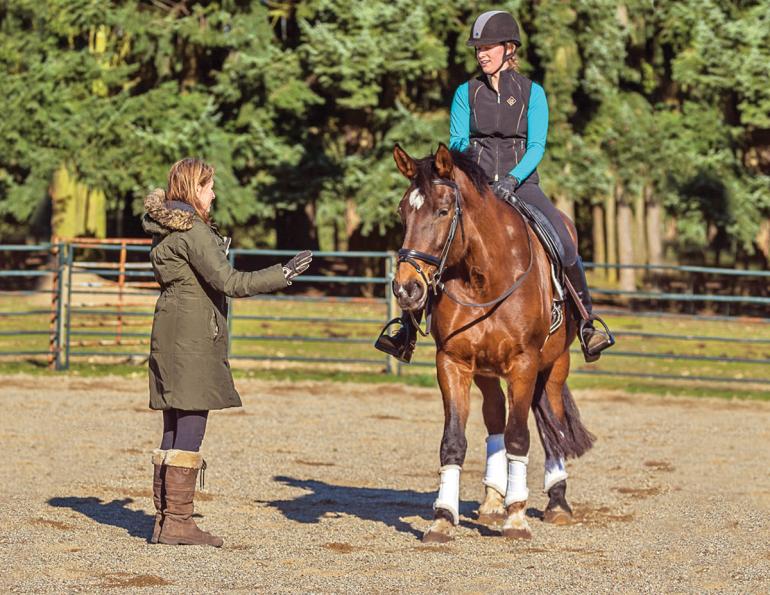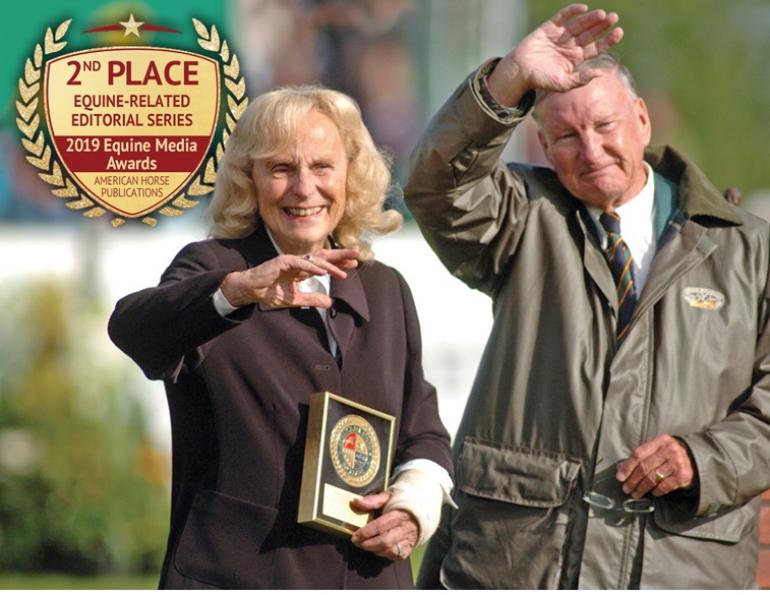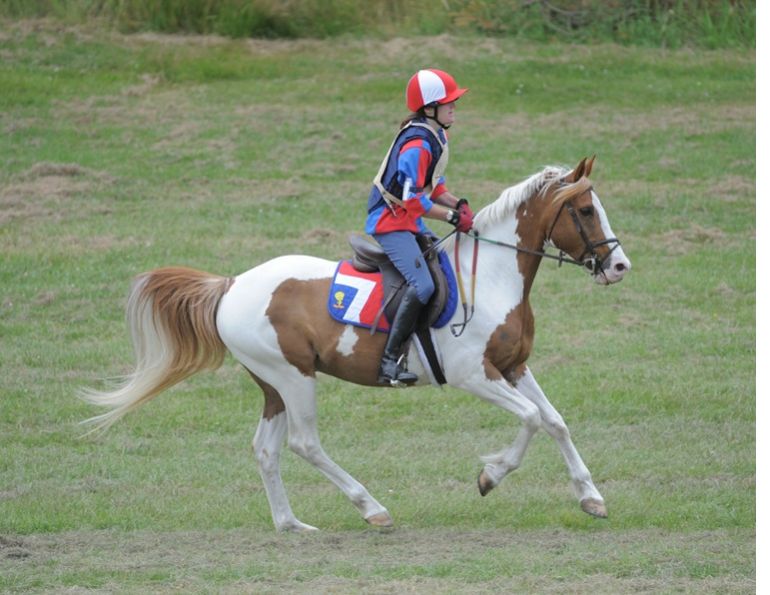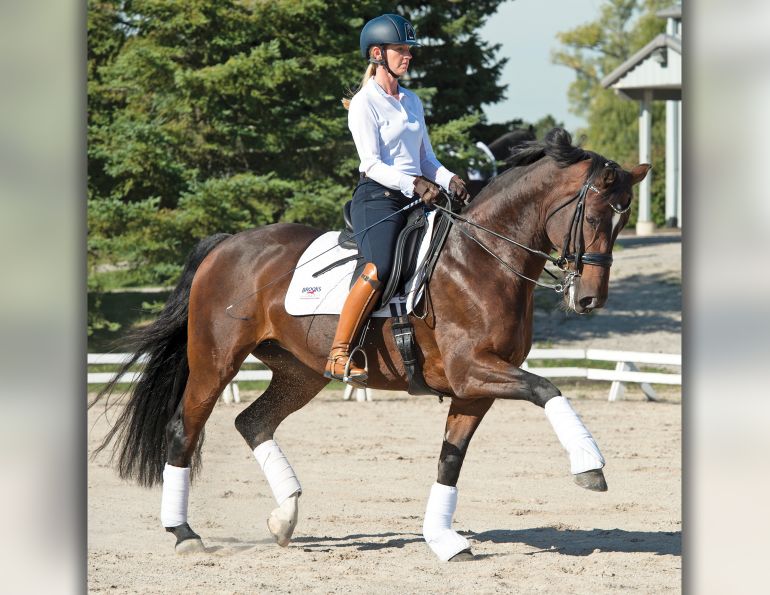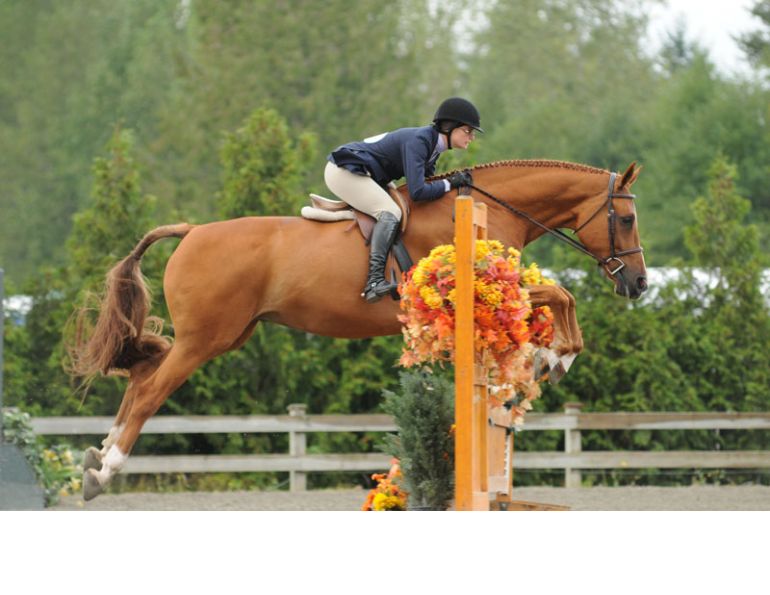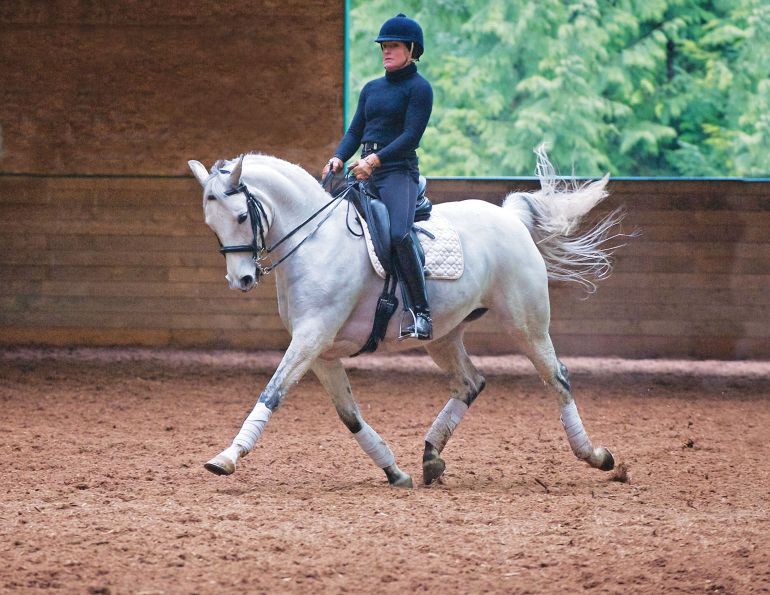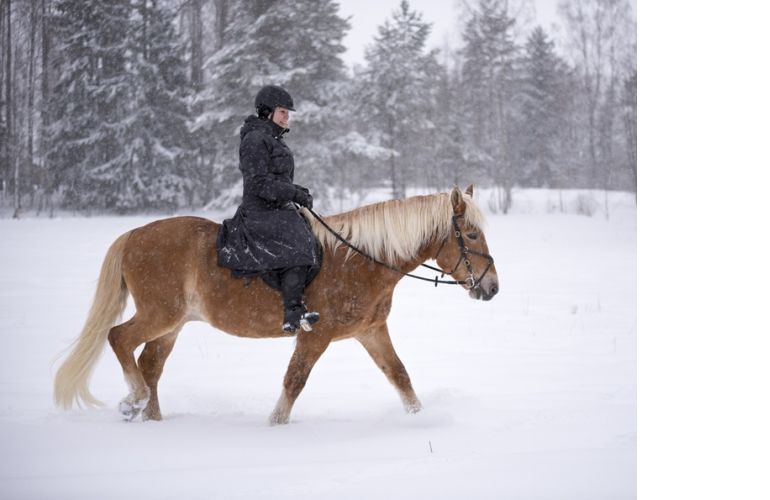By Gina Allan and Barb Kopacek
Are you striving for a balanced and effective riding posture? We can help you find success. A key checkpoint while riding is ensuring your ears, shoulders, hips, and heels align. Can you maintain this posture in the saddle? If yes, you’re on the right track to refining your skills. If not, don’t worry; consistent practice with the right rider alignment exercises will strengthen your position over time.
Like the work of improving our horse’s strength, suppleness, and range of motion laterally and longitudinally, we must also develop our own balance, mobility, and core stability. Accomplishing even strength and flexibility throughout the body is essential for maintaining a proper riding posture and preventing imbalances.
Related: Mounted Exercises to Improve a Horse Rider's Seat and Effectiveness
In this guide, we’ll break down rider body alignment from a horizontal perspective, examining posture from front to back. You’ll also discover common riding position mistakes and specific exercises for equestrians to help correct them, ensuring you and your horse move in harmony.

Just like our horses, riders must be conditioned both laterally and longitudinally for an even balance of muscle strength and flexibility to achieve a strong, classical position. Photo: Nancy Adams/Hooves Included Photography
Have you ever been told that you are leaning your upper body too much to one side of your horse? Perhaps you collapse into your waistline on one side and your ribs sink into your hips. Maybe you push your hip off to the outside or to one side of your horse’s spine or rotate at your waist or through your pelvis, causing your body to twist in one direction as you ride. These and many other deviations in position can be the direct result of habitual patterning or one-sidedness resulting from your daily routines. Other deviations could be the result of asymmetrical patterns arising from an injury such as a fall from a horse. Sitting for extended periods of time with one leg crossed over the other, for example, or sitting too much on one seat bone, standing on one foot more than the other, or cocking one hip when you stand for extended periods can all wreak havoc on the body.
If you can dedicate short periods of time to paying attention to yourself throughout your day, you can easily make positive changes to your posture, your riding position, and your overall physical health - and you don’t need to spend a single dollar on a personal trainer. Just simply pay attention.
Here are some ideas to help you make simple but effective changes to your posture and to your life.
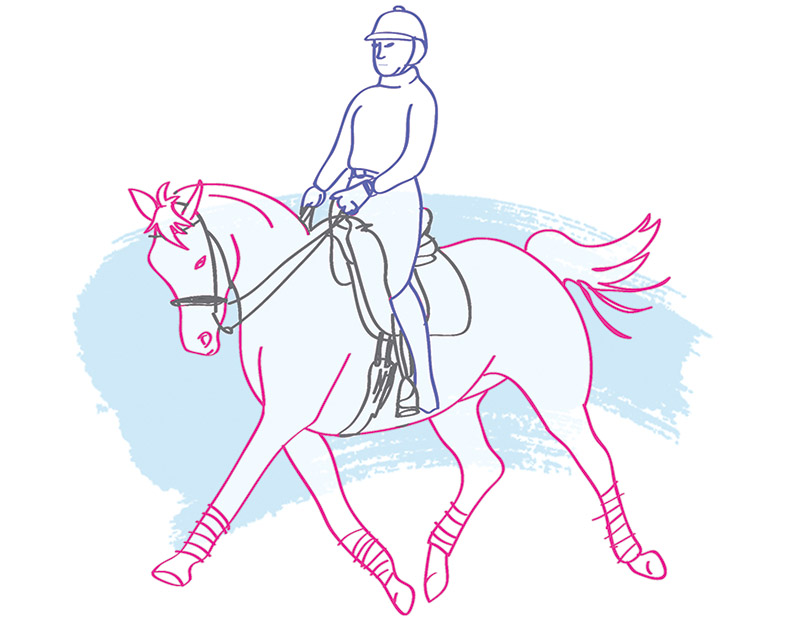
Try to observe yourself throughout your day. Do you sit more on one seat bone when at the computer or in your car? Do you clean your horse’s stall with the pitch fork always on the same side of your body? Minor deviations like this will, over time, cause imbalances in muscle strength, flexibility, and alignment of the spine and pelvis, which in turn affect your posture and riding position. With awareness and focus these anomalies can be corrected in a relatively short period of time.
Why not begin your day in three-point-touch position (described below), which can be done while eating a meal, brushing your teeth, and driving your car. Observe how you sit at your computer. Are you squarely positioned on your seat bones? Is your chin protruding? Do you slouch in the vulture pose? Do your knees wow outward or inward? Are your heels elevated causing your calf muscles to contract? Do you twist at the waist or in the pelvis when sitting or driving your car? Do you have to rotate at your computer to reach your keyboard or other piece of frequently used office equipment? Repetitive rotation in one direction will cause imbalances in the torso.
Related; Fitness for Fun! Exercises for Young Horse Riders
Let’s suppose you are right-handed and have a tendency to sit more on your right hip. Maybe you put five to ten percent more weight on that side of your 130-pound body. That’s seven to thirteen more pounds (the approximate weight of a bowling ball) on one side of your spine and pelvis. Now imagine doing that for four to six hours a day. The weighted side will be compressed and the muscles will be more contracted (shorter) and weaker on that side. The opposite side of the pelvis and spine will become stretched, and likely more mobile, which causes excessive wear and tear to related joints of the lumbar and sacral regions on that side, making injury highly likely. Over time this dysfunctional pattern will cause the joints to become stressed. If you find you are crooked, correct this situation by sitting squarely as if you were seated in a canoe and attempting to keep it level. Also, ensure that your keyboard and other office equipment you use regularly are directly in front of you as you work.
If you can change patterns of imbalance, you can change and improve your riding position.
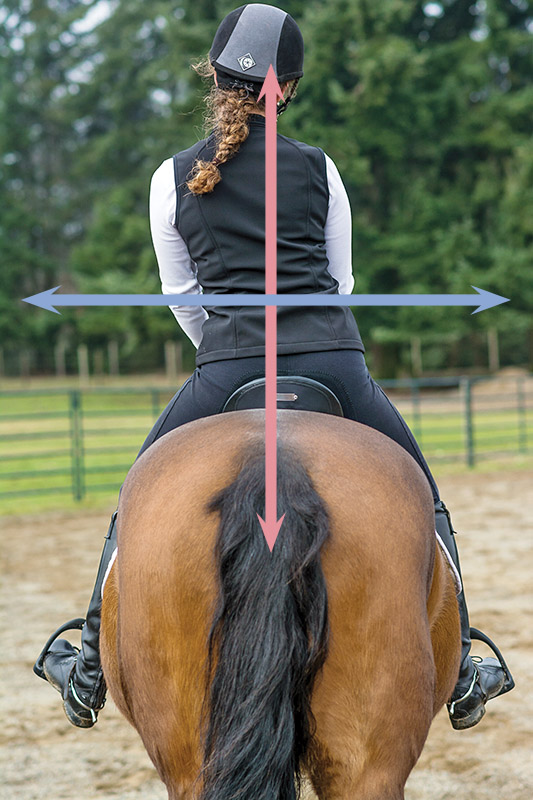
Deviations in rider position can negatively impact your riding, but with focus and awareness can be corrected in a relatively short period of time. Photo: Nancy Adams/Hooves Included Photography
Try the following exercises at home or at your workplace. Keep in mind that sitting for more than 20 minutes at a time has been linked to type 2 Diabetes, so get up often and stretch. Try doing one-legged balance stands.
By mindfully observing your daily posture you will begin to make small but significant changes to your body and riding position. Your equine partner is sure to enjoy your new balanced position as well.
The following exercises can be practiced at home, outside, at the barn, or at your workplace. Try to do them regularly to improve your posture, back health, and that much sought-after classical position.
Exercise #1 Three-Point-Touch
Begin by standing with your back against the wall, feet about hip width apart. Ensure your balance is even between your forefeet and your heels. Lift your instep slightly to put a bit of pressure on the outer parts of your feet. Your legs should be straight but not locked at the knees. From here, there are three points of contact we will be working with: the back of your head, the upper back between your shoulder blades, and your pelvis. Position your pelvis so your tailbone is pointing at the floor. Contract the front of your pelvis as if you’re trying to stop the flow of urine and pull your navel in towards your spine and up towards your sternum. Try to avoid tipping your pelvis by imagining it’s like a bowl of water – keep the water level in the bowl. Lift your rib cage up out of your hips as if you are being picked up by your underarms. This will enable the back of your rib cage – an area that is all too often overlooked but plays an integral role in posture – to lift also. Broaden and lower your shoulders while keeping the lift in your torso. Place your shoulder blades against the back of your rib cage so that your upper back can lay flat against the wall. It is important to avoid scrunching up your shoulders. With your arms straight at your sides and palms facing forward, lengthen the back of your neck as if your head was being lifted like a marionette. This will also help you maintain the lift in your torso. Keep your chin parallel to the ground while gently drawing it in and touch the back of your head to the wall. Now you’ve achieved the three-point-touch.
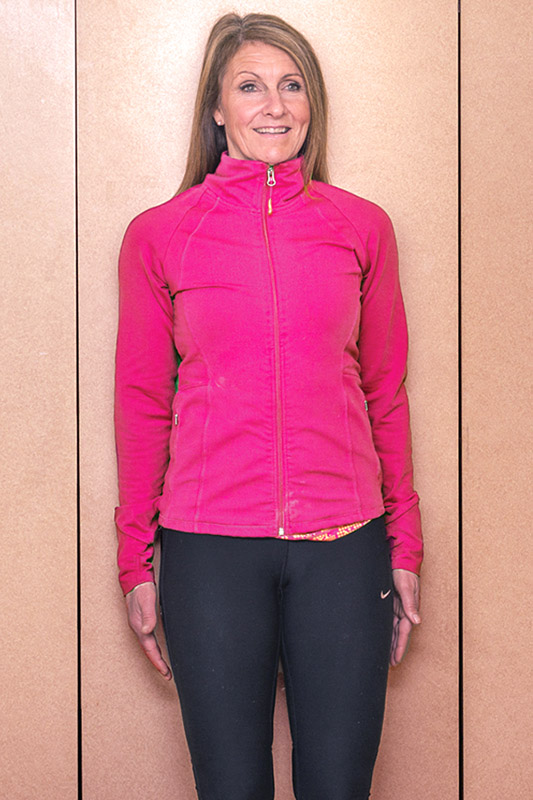
Exercise #2 Arms Overhead
Bring yourself from three-point-touch into a small pelvic tilt with your lower back pressing into the wall by contracting your abdominals. Ensure your palms are facing inward. Slowly, keeping your belly button pulled toward your spine and lower back pressed into the wall, lift your arms overhead. Keep your elbows relatively narrow and shoulders down. Raise your arms overhead until your thumbs and index fingers touch the wall. Press your index finger and thumb into the wall and hold for a count of 15 to 20 seconds, then gently lower your arms to your side. Repeat two or three times.
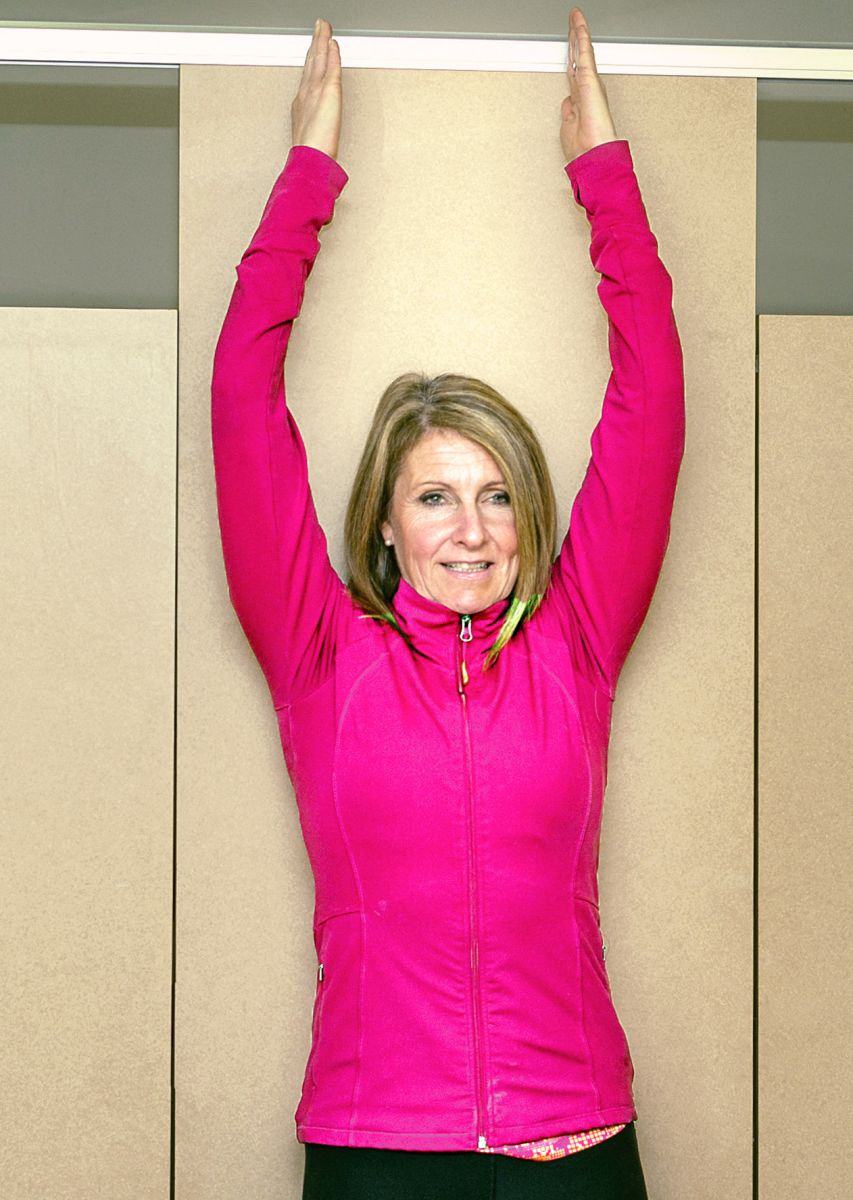
Related: Fitness & Balance for Mature Riders
Exercise #3 Chest Stretch
As you stand in the doorframe, lift your arms to just below shoulder height and bend your elbows so that they come to a 90-degree angle. Try to maintain good three-point-touch position as you spread your arms, keeping your wrists and hands flat to the frame. Gently press forward so that your upper body attempts to come through the doorframe and hold the stretch for 30 seconds to one minute. Repeat frequently.
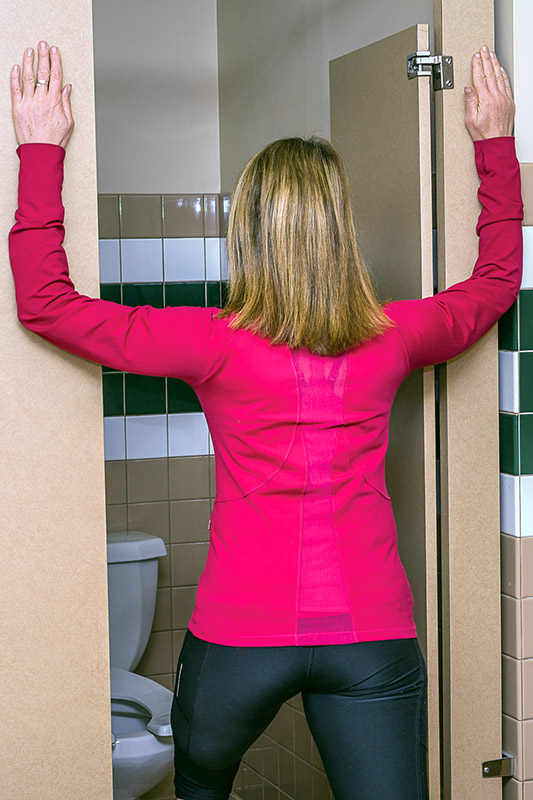
Exercise #4 Strengthening Quadriceps
Wall squats develop quads and glutes, improve leg development in alignment, and increase balance and stability through the leg. They also help the body prepare for posting trot and strong position. Stand with your back to the wall keeping your feet hip width apart and about .5 metre (1.6 feet) out from the wall. Ensure your legs are straight but not locked to start. Slowly lower yourself by sliding down the wall until your knees are slightly above 90 degrees. Try to keep your knees tracking in line with your middle toe but do not let them pass in front of your ankles. Hold for five to twenty seconds. Repeat three to five times.
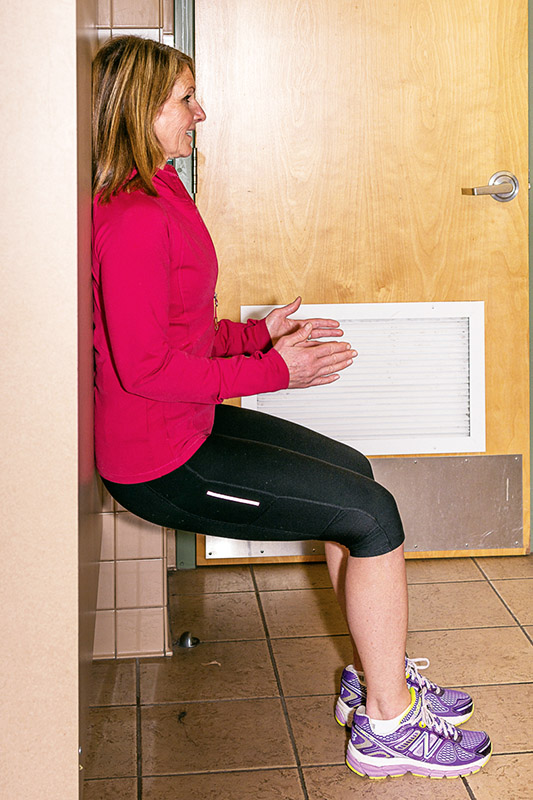
Exercise #5 Wall squats with single leg lifts
Position your body the same as for wall squats. Ensure your core is engaged and that you maintain good three-point-touch position while stabilizing yourself with hands on the wall. To start, slowly bend your right leg to 90 degrees and hold for three to five seconds. Lower your right leg to the floor, then do the same with your left leg. Repeat this exercise up to 10 times.
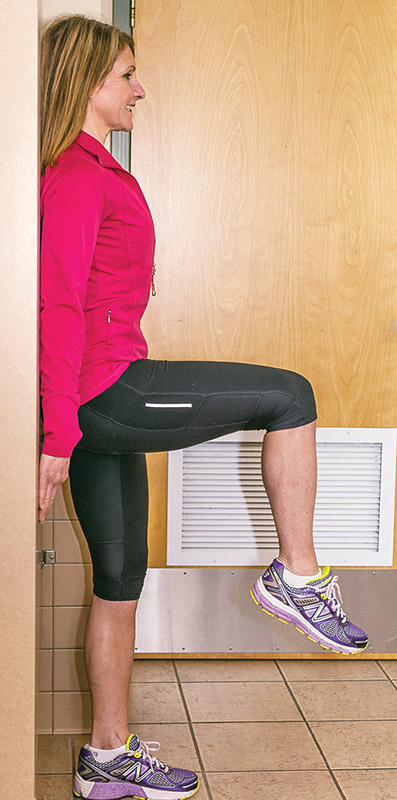
Exercise #6 Stretch Sitting
Begin by sitting squarely on your seat bones and good three-point-touch position. Ensure your knees and legs are at 90 degrees. Bring your right ankle up and cross it over your left leg above the knee joint. Gradually begin to hinge forward at the hip, keeping your back straight and in three-point-touch alignment. Feel the stretch deep in the right hip and the outside of the thigh. Hold for 30 seconds and repeat with the other leg.

Exercise #7 Chest Stretch on desk (or tree)
Sit or stand in good three-point-touch position with your arms outstretched and hands on the top of your desk or tree, or even your kitchen or bathroom counter. Hinging at the hips, bring your upper body to 90 degrees. Gently press your chest forward as if trying to press your sternum to the ground and hold for 30 seconds to one minute.
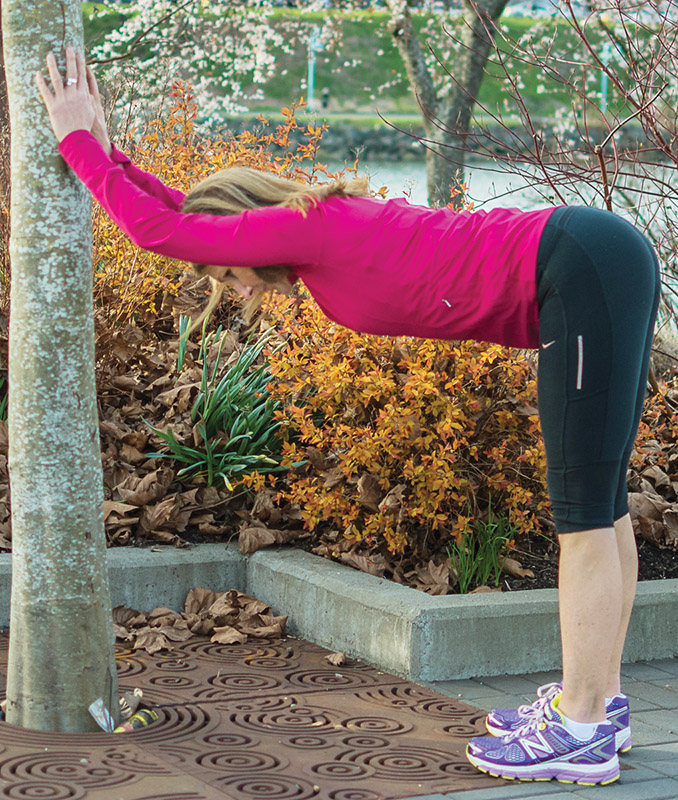
Related: Using Fitness for Better Balance & Relaxation
Exercise #8 Knee to Chest Stretch
Sit in good alignment on a chair keeping your legs bent. Gently bring one knee into your chest. Stay tall in your torso and ensure you are seated evenly on your seat bones. Hold 30 seconds to one minute and repeat with other leg.

Exercise #9 Desk Push-up
This exercise will help to increase strength and upper body stability. Begin by facing your desk with your hands approximately shoulder width apart. Engage your core as in three-point-touch position, keep your abs engaged and your shoulders back and down. Inhale. Then, as you exhale, begin to lower your body towards the desk by bending your arms so that your elbows glide in towards your ribs. Inhale while returning to starting position. Repeat 8 to 15 times and work up to two sets of 12 to 15 reps.
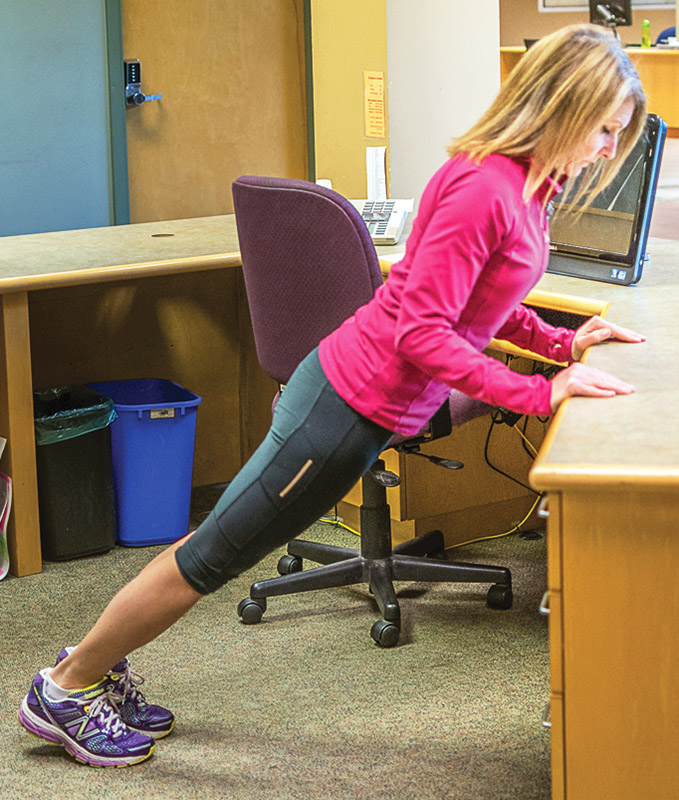
Exercise #10 Quadriceps Stretch
Standing tall with your knees soft, contract your abdominals in and up. Stand on your left leg while bending your right knee and bring your heel towards your seat. Clasp your ankle or pant leg with your right hand and keep your pelvis tucked under to protect your back. Try to bring your knees together under your hips. Breathe and hold for 30 seconds to one minute. Repeat with other leg.

Exercise #11 Hamstring Stretch
Begin standing in three-point-touch position. You can do this standing or seated by placing one leg forward so just your heel rests on the ground and straighten that leg. Your other leg will be slightly bent. With thighs parallel, hinge forward at your hips keeping a straight back and your abdominals engaged. Place your hands on the upper thigh of the bent leg while keeping your weight over that leg to keep from over extending the knee. Hold for 15 to 60 seconds and then repeat on other side.

Related: Pilates for Equestrians
Related: Rider Posture - What is Actually Involved?
All photos by Nancy Adams/Hooves Included Photography.



